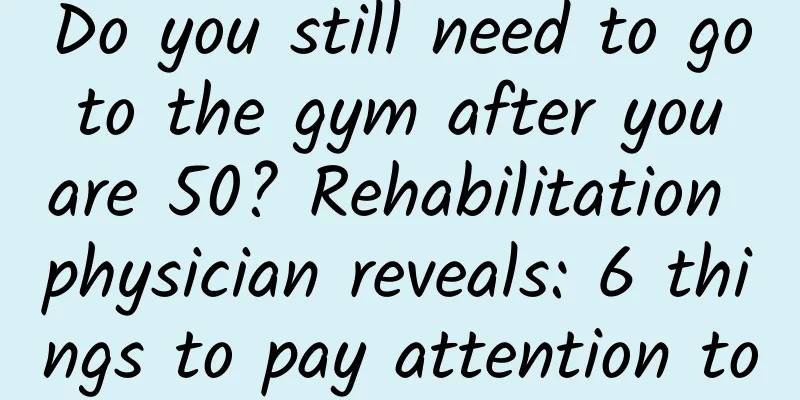Do you still need to go to the gym after you are 50? Rehabilitation physician reveals: 6 things to pay attention to

|
In the early days of my career (when I was promoted to attending physician), I would sometimes suggest to my patients in the clinic that "if you need to improve your basic physical fitness, you can consider going to the gym." Many elderly outpatients often wonder: "Doctor, I am already 60 years old, do I need this?" Today, it is not uncommon to see people over 50 going to the gym. I have patients in their 90s who still continue to exercise in the gym. I am also happy to see more and more people joining the ranks of fitness. If you don't have the habit of going to the gym yet and are thinking of joining? Or have you just joined? Perhaps taking a look at the following suggestions in this article can give you some good help and ideas. 6 things to pay attention to when going to the gym1. Consult your doctor to consider the risks of exerciseTheoretically, if you have any underlying diseases, you should consult your doctor before starting exercise. Each of us has different diseases or conditions, so the things we should pay special attention to will also be different. However, for people over 50 years old, it is even more important to consult their doctors. After all, as you age, some medical diseases that you didn't have when you were young may slowly emerge. For example, diabetes, high blood pressure, etc. According to the American College of Sports Medicine, people with poorly controlled diabetes and hypertension should first control their condition to a certain level before starting exercise. Otherwise, your body will be at a relatively high risk during exercise. Even if the condition is well controlled, we should also pay attention to the risks of the disease during exercise. For example, if a diabetic patient does not pay attention to nutritional supplements before exercise, the chance of hypoglycemia during exercise may increase. If you are not sure whether you have any underlying diseases, then take this opportunity before going to the gym to arrange a health check for yourself. Although I am a rehabilitation physician, in clinical practice, I often hear patients share that they always thought they were healthy, but later found out during a health check that they had...similar diseases. 2. Create your own fitness planJust like studying requires a study plan, fitness certainly requires a fitness plan. Just like why we study Chinese today and math tomorrow. We have a plan for the content of each of our training sessions. For example, if we train lower limb strength and do cardio training on a rowing machine today, then next time we will plan to train upper limb strength and core and do cardio training on a bicycle. We should all have some ideas about the number, duration, content, and intensity of our weekly training. Maybe someone will say, I just want to start exercising, is it really necessary to make it so troublesome? What I want to say here is that starting to exercise is the biggest progress, but if you want to be relatively "safe" and "effective", then setting a goal first, planning a plan, and working hard to implement it is a very good way. Some people may ask, what should I do if I don’t have this knowledge? After all, none of us are born with knowledge. If you don’t know something, ask a professional. If you don’t have financial considerations, you can ask a professional fitness trainer to take you through exercise and arrange a plan. If you have financial considerations, you may want to start by simply arranging your exercise in terms of frequency and time. You can also ask friends who have fitness habits, or your children who have experience to give advice (of course, the premise is that your friends and children have certain correct concepts). If not, you can also consult your rehabilitation physician to ask how to start? Starting to exercise is the biggest step forward, but if you want to be relatively "safe" and "effective", then setting a goal first, planning a plan, and working hard to implement it is a good way. 3. Warm up beforehand and stretch afterwardsWarming up before exercise can reduce the chance of sports injuries, increase blood flow, promote muscle elasticity, and allow our muscles and joints to reach a state of preparatory activity. Stretching after exercise can lengthen tight muscles and reduce muscle soreness. Regular stretching can increase joint range of motion and muscle flexibility, reducing the body's muscle imbalances that cause compensation. 4. Adequate nutrition, remember to replenish water and saltAdequate nutrition is something that needs to be paid attention to at every age, especially after regular exercise. If there is adequate nutritional supplementation, it can have a multiplier effect on health and body composition. Here the author would like to remind you to replenish water and salt. After all, exercise will make us sweat a lot. Replenishing water between exercises can avoid dizziness and imbalance. If there is no replenishment of water and salt after exercise, it can easily cause ion imbalance. Excessive sweating without replenishing water and salt can easily lead to ion imbalance in the body and cause health hazards in older people. 5. Suitable sportswearSuitable clothing includes clothing for exercise and for the journey home. Of course, the main thing during exercise is to be comfortable, light, and not affect your movements. Here the author mainly reminds you about what to wear on the way home after exercise. It's OK in the summer, but in the winter, we feel warm after exercising and taking a shower, but as soon as we walk out of the gym, the cold wind blows and our whole body shivers. For some older people, The body is sometimes not so adaptable to short-term temperature changes. Therefore, it is very important to keep the body warm, which can reduce the chance of cardiovascular accidents. 6. Learn to deal with delayed onset muscle sorenessPeople who don't exercise regularly are more likely to develop delayed onset muscle soreness if they suddenly go to the gym. Even for people who exercise regularly, delayed onset muscle soreness may occur if the intensity or duration of exercise changes too much, or the amount of training increases too much in a short period of time: for example, a 1km long-distance run suddenly becomes a 2km run; or a 20kg squat, 3 sets of 10 reps each, becomes 30kg each. From the word "delayed" in the name, we know that it usually occurs after exercise, and there will be obvious discomfort about 24-48 hours after exercise. It has nothing to do with muscle strain or sprain during exercise. Delayed onset muscle soreness is mainly related to minor injuries to muscle fibers. These minor injuries cause tissue inflammation, resulting in subsequent changes in osmotic pressure, increased cellular metabolites, and affecting nearby nerve receptors, resulting in symptoms of muscle soreness. We can relieve the pain through massage, stretching, or hot water soaking after exercise, but according to evidence, there is no particularly good way to improve it, and the differences between individuals are very different. Simply put, delayed onset muscle soreness occurs mainly because our bodies have not yet adapted to the new intensity. As our abilities increase, these conditions will improve. What I fear most is that I finally make up my mind to work out, but the first time I experience delayed onset muscle soreness, I get scared and never work out again. Isn’t that a pity? Of course, if the muscle soreness lasts too long, does not improve for more than a week, and feels hot and swollen to the touch, it may not be as simple as delayed onset muscle soreness, and you must seek the help of a professional doctor. Exercise and keep fit Once we are well prepared, we can start exercising and keeping fit. During the training process, you may feel tired and often want to be lazy, but when the training is over, your body and mind will give you a comfortable feeling, and you may even be grateful that you did not slack off today. This article was provided by Taiwan Rehabilitation Medicine Association Author of this article: Dr. Jiang Yanyi of Yuemanyi Rehabilitation Clinic |
Recommend
Can one patch really help you lose belly fat? Combine with sit-ups
Sports tape has a magical effect. It has a modify...
What to do if women have irregular menstruation? 3 tips to regulate menstruation
Irregular menstruation in women can be regulated ...
The cause of cervical erosion is also related to viral infection
From the physiological structure of the female ce...
Does it hurt when you urinate as if something is stuck? Be careful of urinary stones! Nutritionist Hou Wenyi: 5 tips for drinking water correctly
When people find that the amount of urine is smal...
Where is the best place to treat endometriosis?
Since women are more likely to suffer from endome...
Experts analyze the causes of vaginitis in daily life
Patients with vaginitis all know that there are m...
Will the stomach hurt after miscarriage? Check out the following content
Women must take good care of themselves in the ea...
Does pelvic effusion affect the uterus?
Will pelvic effusion affect the uterus? 1. If pel...
Experts explain the main examination methods for severe cervical erosion
Timely examination of severe cervical erosion is ...
What are the main causes of ectopic pregnancy?
What are the main causes of ectopic pregnancy? I ...
Loving to eat sweets not only makes you fat, it also hurts your heart! Nutritionist You Weiming: 2 tips to avoid sugar harm
When the weather is hot, many people like to sip ...
Eat the right fruits to lose weight! Golden time is in the morning
Fruits are foods with the highest water content. ...
What is adenomyosis?
What is adenomyosis? What is it? 1. Adenomyosis i...
A brief discussion on several nursing measures for vulvar leukoplakia
Vulvar leukoplakia is hereditary and very harmful...
Can people with uterine fibroids eat yuba?
Can people with uterine fibroids eat yuba? 1. Pat...









